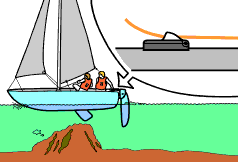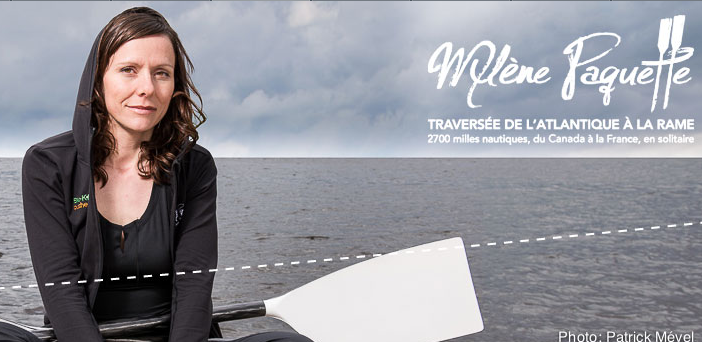Le Gulf Stream
par Equipe au sol le 16 juillet 2013 (extrait du blog de Mylène Paquette)
Pour faire suite au dernier blog de Mylène et mieux comprendre son parcours sur l’océan, voici une nouvelle capsule (signée Martin Castonguay et Sophie Renaut) sur le courant du Gulf Stream que Mylène veut atteindre, et qui nous explique la direction de ce dernier :
Parcours du Gulf Stream dans l’océanCapsule n°4:
Le Gulf Stream a été décrit com me une rivière au milieu de l’océan. Il s’agit d’un courant océanique majeur et chaud de de l’océan Atlantique. Il prend naissance dans le Golfe du Mexique, et remonte le long de la côte Est des États-Unis et du Canada pour ensuite bifurquer vers l’Est, et longer les côtes européennes. La partie sud du Gulf Stream s’appelle le courant de Floride qui écoule au-dessus du plateau continental entre la Floride et les Bahamas. Le courant de Floride longe la côte des USA puis bifurque vers le nord-est au Cap Hatteras (au large de la Caroline du Nord) et quitte alors le plateau continental pour devenir le Gulf Stream à proprement parler. Il s’écoule dans l’Atlantique vers le nord-est jusqu’aux Grands Bancs de Terre-Neuve, après quoi il vire à l’est et devient le courant Nord-Atlantique. Le débit du Gulf Stream est très fort avec plusieurs variations, et atteint un maximum à la hauteur des Grands Bancs. La circulation thermohaline et le fameux tapis roulant océanique sont une conséquence de la circulation océanique forcée par l’atmosphère dont fait partie le Gulf Stream.
me une rivière au milieu de l’océan. Il s’agit d’un courant océanique majeur et chaud de de l’océan Atlantique. Il prend naissance dans le Golfe du Mexique, et remonte le long de la côte Est des États-Unis et du Canada pour ensuite bifurquer vers l’Est, et longer les côtes européennes. La partie sud du Gulf Stream s’appelle le courant de Floride qui écoule au-dessus du plateau continental entre la Floride et les Bahamas. Le courant de Floride longe la côte des USA puis bifurque vers le nord-est au Cap Hatteras (au large de la Caroline du Nord) et quitte alors le plateau continental pour devenir le Gulf Stream à proprement parler. Il s’écoule dans l’Atlantique vers le nord-est jusqu’aux Grands Bancs de Terre-Neuve, après quoi il vire à l’est et devient le courant Nord-Atlantique. Le débit du Gulf Stream est très fort avec plusieurs variations, et atteint un maximum à la hauteur des Grands Bancs. La circulation thermohaline et le fameux tapis roulant océanique sont une conséquence de la circulation océanique forcée par l’atmosphère dont fait partie le Gulf Stream.
Martin Castonguay
Québec-Océan
Chercheur et chef de section Évaluation et conservation poissons à l’Institut Maurice-Lamontagne, MPO
Et
Sophie Renaut
Québec-Océan
———————————————————————————————————————————————————————
The Gulf Stream
Following Mylène’s last blog and to better understand her route along the ocean, here is a new capsule (by Martin Castonguay et Sophie Renaut) on the Gulf Stream current that Mylène wants to reach, and explains to us the direction of this current:
Route of the Gulf Stream in the Atlantic Ocean
Capsule #4
The Gulf Stream has been described as a river in the middle of the ocean. It is a major warm ocean current in the Atlantic Ocean. It originates in the Gulf of Mexico, and goes up along the east coast of the United States and Canada, then branches off to the East, and along the coasts of Europe. The Southern part of the Gulf Stream which flows over the continental shelf between Florida and the Bahamas is called the Florida Current. The Florida Current goes along the coast of the U.S. then turns North-East to Cape Hatteras (off North Carolina) and then leaves the continental shelf to become the Gulf Stream itself. It flows into the Atlantic north-east to the Great Banks of Newfoundland, after which it turns East and becomes the North Atlantic Current. The flow of the Gulf Stream is very strong with several variations, and reaches a maximum at the height of the Grand Banks. Thermohaline circulation and the famous ocean conveyor belt is a consequence of ocean circulation forced by the atmosphere of which the Gulf Stream is a part.
Martin Castonguay
Québec-Océan
Researcher and Head of Section Evaluation and fish conservation at the Maurice Lamontagne Institute, DFO
-and-
Sophie Renaut
Québec-Océan
Doctoral student in Oceanography at the University Laval









































